外科打结法
- 格式:ppt
- 大小:1.98 MB
- 文档页数:20
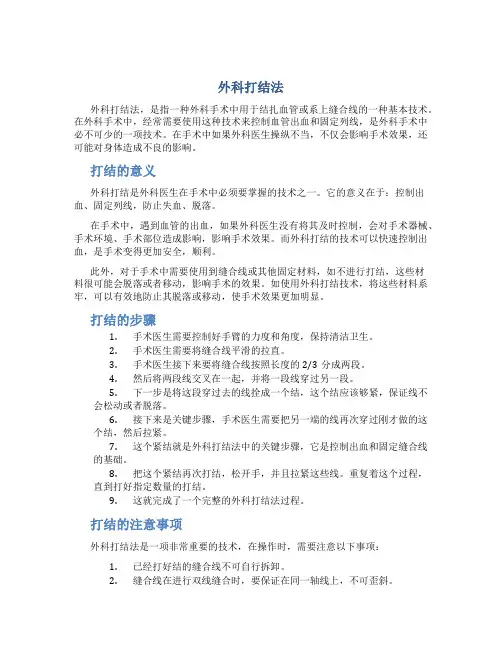
外科打结法外科打结法,是指一种外科手术中用于结扎血管或系上缝合线的一种基本技术。
在外科手术中,经常需要使用这种技术来控制血管出血和固定列线,是外科手术中必不可少的一项技术。
在手术中如果外科医生操纵不当,不仅会影响手术效果,还可能对身体造成不良的影响。
打结的意义外科打结是外科医生在手术中必须要掌握的技术之一。
它的意义在于:控制出血、固定列线,防止失血、脱落。
在手术中,遇到血管的出血,如果外科医生没有将其及时控制,会对手术器械、手术环境、手术部位造成影响,影响手术效果。
而外科打结的技术可以快速控制出血,是手术变得更加安全,顺利。
此外,对于手术中需要使用到缝合线或其他固定材料,如不进行打结,这些材料很可能会脱落或者移动,影响手术的效果。
如使用外科打结技术,将这些材料系牢,可以有效地防止其脱落或移动,使手术效果更加明显。
打结的步骤1.手术医生需要控制好手臂的力度和角度,保持清洁卫生。
2.手术医生需要将缝合线平滑的拉直。
3.手术医生接下来要将缝合线按照长度的2/3分成两段。
4.然后将两段线交叉在一起,并将一段线穿过另一段。
5.下一步是将这段穿过去的线拴成一个结,这个结应该够紧,保证线不会松动或者脱落。
6.接下来是关键步骤,手术医生需要把另一端的线再次穿过刚才做的这个结,然后拉紧。
7.这个紧结就是外科打结法中的关键步骤,它是控制出血和固定缝合线的基础。
8.把这个紧结再次打结,松开手,并且拉紧这些线。
重复着这个过程,直到打好指定数量的打结。
9.这就完成了一个完整的外科打结法过程。
打结的注意事项外科打结法是一项非常重要的技术,在操作时,需要注意以下事项:1.已经打好结的缝合线不可自行拆卸。
2.缝合线在进行双线缝合时,要保证在同一轴线上,不可歪斜。
3.手术医生应当在适当的范围内掌控力度和角度,避免造成患者不必要的疼痛和不良反应。
4.打结时,要保持清洁,并在浸有消毒液的纱绒中拭取线缆,避免滑动不稳。
外科打结法是一项外科手术中必不可少的技术,掌握好外科打结的技术,对于病人的恢复和手术效果会产生积极的影响。
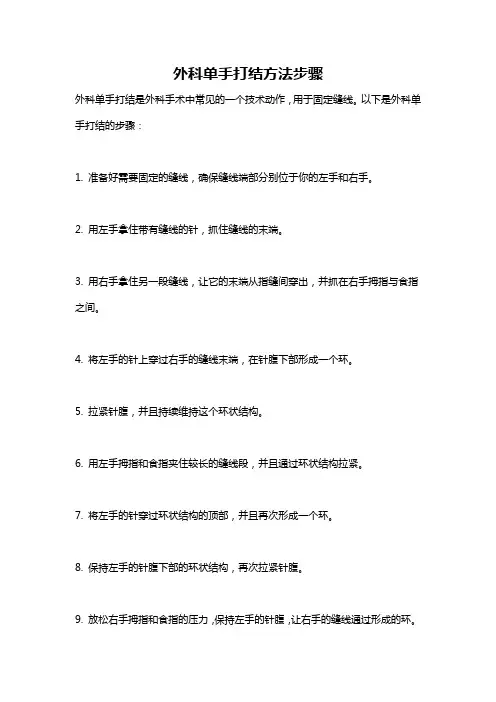
外科单手打结方法步骤
外科单手打结是外科手术中常见的一个技术动作,用于固定缝线。
以下是外科单手打结的步骤:
1. 准备好需要固定的缝线,确保缝线端部分别位于你的左手和右手。
2. 用左手拿住带有缝线的针,抓住缝线的末端。
3. 用右手拿住另一段缝线,让它的末端从指缝间穿出,并抓在右手拇指与食指之间。
4. 将左手的针上穿过右手的缝线末端,在针腹下部形成一个环。
5. 拉紧针腹,并且持续维持这个环状结构。
6. 用左手拇指和食指夹住较长的缝线段,并且通过环状结构拉紧。
7. 将左手的针穿过环状结构的顶部,并且再次形成一个环。
8. 保持左手的针腹下部的环状结构,再次拉紧针腹。
9. 放松右手拇指和食指的压力,保持左手的针腹,让右手的缝线通过形成的环。
10. 将右手拇指和食指夹住较长的缝线段,并且通过形成的环拉紧。
11. 检查并调整结扎的紧度和结扎的位置,直至满意。
12. 剪掉多余的缝线。
请注意,以上步骤仅为参考,实际操作过程中可能因个人习惯和技术要求略有不同。
在进行外科单手打结时,请确保熟练掌握相关技巧,并且根据实际情况进行适当调整。
最好在受过专业培训的人员指导下进行实践。
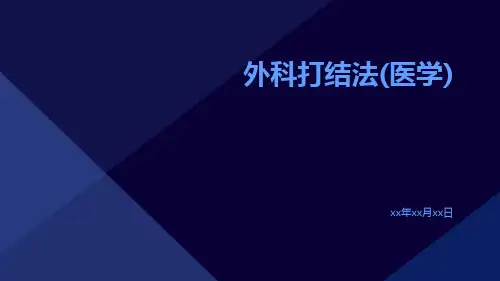
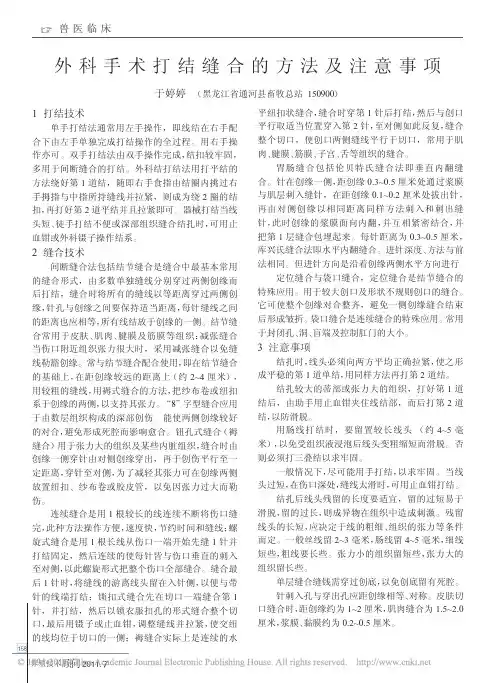
誅兽医临床1打结技术单手打结法通常用左手操作,即线结在右手配合下由左手单独完成打结操作的全过程。
用右手操作亦可。
双手打结法由双手操作完成,结扣较牢固,多用于间断缝合的打结。
外科结打结法用打平结的方法绕好第1道结,随即右手食指由结圈内挑过右手拇指与中指所持缝线并拉紧,则成为绕2圈的结扣,再打好第2道平结并且拉紧即可。
器械打结当线头短、徒手打结不便或深部组织缝合结扎时,可用止血钳或外科镊子操作结系。
2缝合技术间断缝合法包括结节缝合是缝合中最基本常用的缝合形式,由多数单独缝线分别穿过两侧创缘而后打结,缝合时将所有的缝线以等距离穿过两侧创缘,针孔与创缘之间要保持适当距离,每针缝线之间的距离也应相等,所有线结放于创缘的一侧。
结节缝合常用于皮肤、肌肉、腱膜及筋膜等组织:减张缝合当伤口附近组织张力很大时,采用减张缝合以免缝线勒豁创缘。
常与结节缝合配合使用,即在结节缝合的基础上,在距创缘较远的距离上(约2~4厘米),用较粗的缝线,用褥式缝合的方法,把纱布卷或纽扣系于创缘的两侧,以支持其张力。
“8”字型缝合应用于由数层组织构成的深部创伤。
能使两侧创缘较好的对合,避免形成死腔而影响愈合。
钮孔式缝合(褥缝合)用于张力大的组织及某些内脏组织,缝合时由创缘一侧穿针由对侧创缘穿出,再于创伤平行至一定距离,穿针至对侧,为了减轻其张力可在创缘两侧放置纽扣、纱布卷或胶皮管,以免因张力过大而勒伤。
连续缝合是用1根较长的线连续不断将伤口缝完,此种方法操作方便,速度快,节约时间和缝线;螺旋式缝合是用1根长线从伤口一端开始先缝1针并打结固定,然后连续的使每针皆与伤口垂直的刺入至对侧,以此螺旋形式把整个伤口全部缝合。
缝合最后1针时,将缝线的游离线头留在入针侧,以便与带针的线端打结;锁扣式缝合先在切口一端缝合第1针,并打结,然后以锁衣服扣孔的形式缝合整个切口,最后用镊子或止血钳,调整缝线并拉紧,使交纽的线均位于切口的一侧;褥缝合实际上是连续的水平纽扣状缝合,缝合时穿第1针后打结,然后与创口平行取适当位置穿入第2针,至对侧如此反复,缝合整个切口,使创口两侧缝线平行于切口,常用于肌肉、腱膜、筋膜、子宫、舌等组织的缝合。
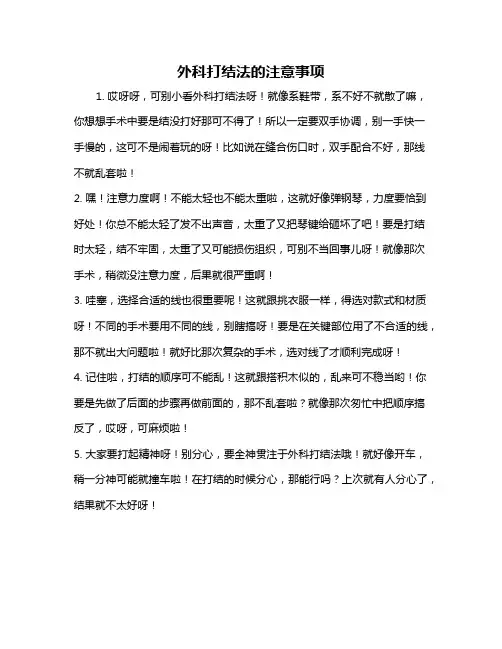
外科打结法的注意事项
1. 哎呀呀,可别小看外科打结法呀!就像系鞋带,系不好不就散了嘛,你想想手术中要是结没打好那可不得了!所以一定要双手协调,别一手快一手慢的,这可不是闹着玩的呀!比如说在缝合伤口时,双手配合不好,那线不就乱套啦!
2. 嘿!注意力度啊!不能太轻也不能太重啦,这就好像弹钢琴,力度要恰到好处!你总不能太轻了发不出声音,太重了又把琴键给砸坏了吧!要是打结时太轻,结不牢固,太重了又可能损伤组织,可别不当回事儿呀!就像那次手术,稍微没注意力度,后果就很严重啊!
3. 哇塞,选择合适的线也很重要呢!这就跟挑衣服一样,得选对款式和材质呀!不同的手术要用不同的线,别瞎搞呀!要是在关键部位用了不合适的线,那不就出大问题啦!就好比那次复杂的手术,选对线了才顺利完成呀!
4. 记住啦,打结的顺序可不能乱!这就跟搭积木似的,乱来可不稳当哟!你要是先做了后面的步骤再做前面的,那不乱套啦?就像那次匆忙中把顺序搞反了,哎呀,可麻烦啦!
5. 大家要打起精神呀!别分心,要全神贯注于外科打结法哦!就好像开车,稍一分神可能就撞车啦!在打结的时候分心,那能行吗?上次就有人分心了,结果就不太好呀!
6. 别忘了多练习呀!熟能生巧嘛,这跟学骑自行车一样,多骑骑就顺溜了!不练习怎么能掌握好外科打结法呢?你看那些熟练的医生,不都是练出来的嘛!就像我当年,拼命练习才有今天呀!
7. 最后呀,一定要严谨!严谨!再严谨!这可不能马虎哟!就跟造房子一样,一点小差错可能导致房子倒塌呀!在外科打结法中不严谨,那后果不堪设想啦!想想都可怕呀!咱可不能拿病人的生命开玩笑呀!总之,外科打结法一定要认真对待,每个细节都关乎着手术的成败呀!。
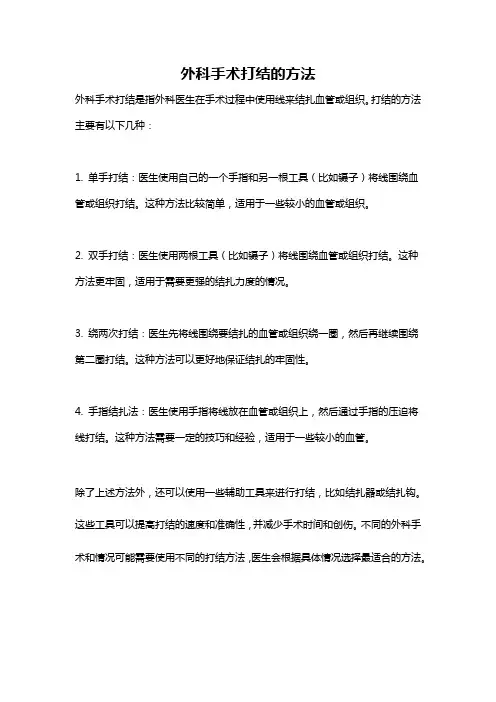
外科手术打结的方法
外科手术打结是指外科医生在手术过程中使用线来结扎血管或组织。
打结的方法主要有以下几种:
1. 单手打结:医生使用自己的一个手指和另一根工具(比如镊子)将线围绕血管或组织打结。
这种方法比较简单,适用于一些较小的血管或组织。
2. 双手打结:医生使用两根工具(比如镊子)将线围绕血管或组织打结。
这种方法更牢固,适用于需要更强的结扎力度的情况。
3. 绕两次打结:医生先将线围绕要结扎的血管或组织绕一圈,然后再继续围绕第二圈打结。
这种方法可以更好地保证结扎的牢固性。
4. 手指结扎法:医生使用手指将线放在血管或组织上,然后通过手指的压迫将线打结。
这种方法需要一定的技巧和经验,适用于一些较小的血管。
除了上述方法外,还可以使用一些辅助工具来进行打结,比如结扎器或结扎钩。
这些工具可以提高打结的速度和准确性,并减少手术时间和创伤。
不同的外科手术和情况可能需要使用不同的打结方法,医生会根据具体情况选择最适合的方法。
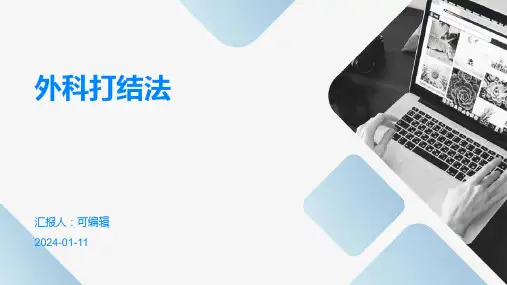
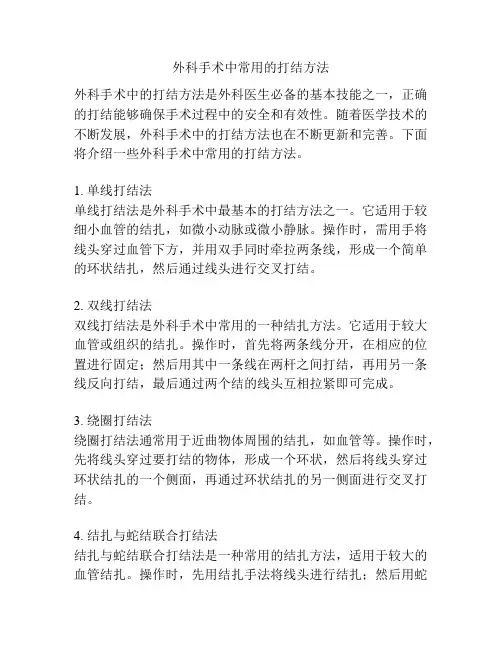
外科手术中常用的打结方法外科手术中的打结方法是外科医生必备的基本技能之一,正确的打结能够确保手术过程中的安全和有效性。
随着医学技术的不断发展,外科手术中的打结方法也在不断更新和完善。
下面将介绍一些外科手术中常用的打结方法。
1. 单线打结法单线打结法是外科手术中最基本的打结方法之一。
它适用于较细小血管的结扎,如微小动脉或微小静脉。
操作时,需用手将线头穿过血管下方,并用双手同时牵拉两条线,形成一个简单的环状结扎,然后通过线头进行交叉打结。
2. 双线打结法双线打结法是外科手术中常用的一种结扎方法。
它适用于较大血管或组织的结扎。
操作时,首先将两条线分开,在相应的位置进行固定;然后用其中一条线在两杆之间打结,再用另一条线反向打结,最后通过两个结的线头互相拉紧即可完成。
3. 绕圈打结法绕圈打结法通常用于近曲物体周围的结扎,如血管等。
操作时,先将线头穿过要打结的物体,形成一个环状,然后将线头穿过环状结扎的一个侧面,再通过环状结扎的另一侧面进行交叉打结。
4. 结扎与蛇结联合打结法结扎与蛇结联合打结法是一种常用的结扎方法,适用于较大的血管结扎。
操作时,先用结扎手法将线头进行结扎;然后用蛇结将打结的线头进行绷紧,最后将蛇结锁定住即可完成。
5. 钩尖打结法钩尖打结法适用于特殊情况下,如手术场地狭窄或视野受限。
操作时,首先将线头放入特殊的钩尖镊子中,然后将钩尖镊子插入要结扎的物体内,钩取线头并牵引,形成一个打结。
除了上述常用的打结方法之外,外科手术还有一些其他特殊的打结方法,如反拧打结法、掌握打结法等。
这些方法在特定的手术场景下能够更好地满足手术需求。
在进行任何外科手术时,准确的打结技术是非常重要的。
正确的打结能够确保手术区域的血液供应畅通,避免术后出血和感染的发生,同时也能够缩短手术时间,提高手术效果。
然而,即使掌握了多种打结方法,医生在临床实践中仍需根据手术的具体情况和个体差异进行选择。
打结时需要注意打结的松紧度,以免过松或过紧造成术后并发症。
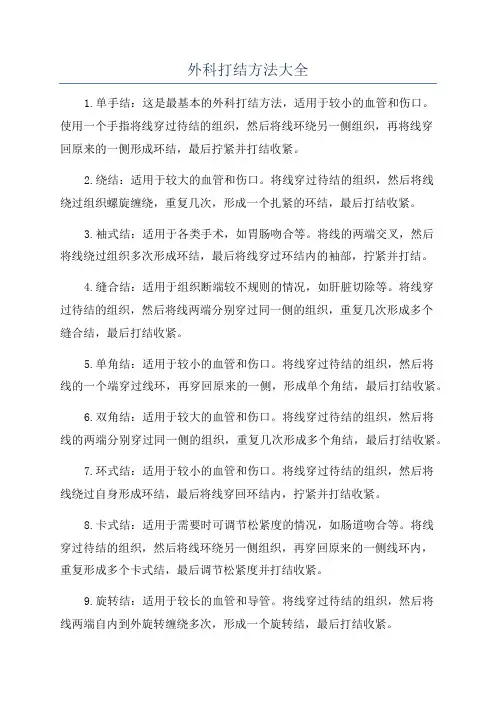
外科打结方法大全1.单手结:这是最基本的外科打结方法,适用于较小的血管和伤口。
使用一个手指将线穿过待结的组织,然后将线环绕另一侧组织,再将线穿回原来的一侧形成环结,最后拧紧并打结收紧。
2.绕结:适用于较大的血管和伤口。
将线穿过待结的组织,然后将线绕过组织螺旋缠绕,重复几次,形成一个扎紧的环结,最后打结收紧。
3.袖式结:适用于各类手术,如胃肠吻合等。
将线的两端交叉,然后将线绕过组织多次形成环结,最后将线穿过环结内的袖部,拧紧并打结。
4.缝合结:适用于组织断端较不规则的情况,如肝脏切除等。
将线穿过待结的组织,然后将线两端分别穿过同一侧的组织,重复几次形成多个缝合结,最后打结收紧。
5.单角结:适用于较小的血管和伤口。
将线穿过待结的组织,然后将线的一个端穿过线环,再穿回原来的一侧,形成单个角结,最后打结收紧。
6.双角结:适用于较大的血管和伤口。
将线穿过待结的组织,然后将线的两端分别穿过同一侧的组织,重复几次形成多个角结,最后打结收紧。
7.环式结:适用于较小的血管和伤口。
将线穿过待结的组织,然后将线绕过自身形成环结,最后将线穿回环结内,拧紧并打结收紧。
8.卡式结:适用于需要时可调节松紧度的情况,如肠道吻合等。
将线穿过待结的组织,然后将线环绕另一侧组织,再穿回原来的一侧线环内,重复形成多个卡式结,最后调节松紧度并打结收紧。
9.旋转结:适用于较长的血管和导管。
将线穿过待结的组织,然后将线两端自内到外旋转缠绕多次,形成一个旋转结,最后打结收紧。
以上是一些常见的外科打结方法,医生根据实际情况和需要选择合适的打结方法。
打结时应注意力度适中,线的张力要均匀,打结后要检查结扎的牢固性,并避免结扎过紧或过松的情况。
正确的打结方法能够有效地控制出血、减少感染的风险,并有助于伤口愈合和病人康复。
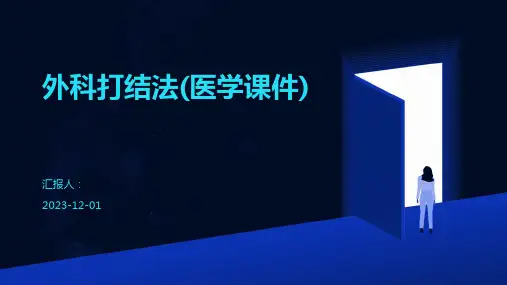
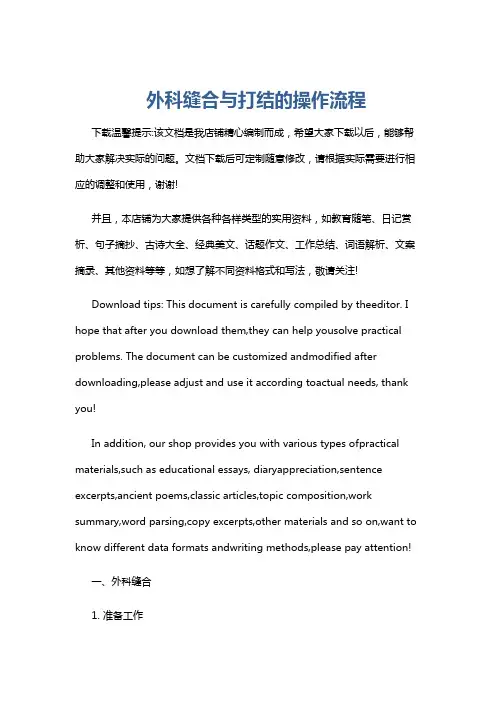
外科缝合与打结的操作流程下载温馨提示:该文档是我店铺精心编制而成,希望大家下载以后,能够帮助大家解决实际的问题。
文档下载后可定制随意修改,请根据实际需要进行相应的调整和使用,谢谢!并且,本店铺为大家提供各种各样类型的实用资料,如教育随笔、日记赏析、句子摘抄、古诗大全、经典美文、话题作文、工作总结、词语解析、文案摘录、其他资料等等,如想了解不同资料格式和写法,敬请关注!Download tips: This document is carefully compiled by theeditor. I hope that after you download them,they can help yousolve practical problems. The document can be customized andmodified after downloading,please adjust and use it according toactual needs, thank you!In addition, our shop provides you with various types ofpractical materials,such as educational essays, diaryappreciation,sentence excerpts,ancient poems,classic articles,topic composition,work summary,word parsing,copy excerpts,other materials and so on,want to know different data formats andwriting methods,please pay attention!一、外科缝合1. 准备工作确保手术区域清洁、干燥,无血迹和异物。
外科打结方法大全1.单手打结方法单手打结方法是外科手术中最常用的打结方法之一、其步骤如下:(1)将线穿过针眼,确保线两端长度相等。
(2)将其中一端线向上折弯成小圈,然后用手撑住将针线一半拉入腔内。
(3)用手拿住针眼弯曲处,将另一半针线部分左右交叉穿过针眼,再放手。
(4)用手括住小团往前缓慢拉动勒紧。
(5)将线穿入腔内形成一个环,调整位置,固定和松紧度。
(6)再次将线穿入腔内形成另一个环,调整位置,固定和松紧度,然后将线两端拉紧引起皮肤松弛。
(7)反复拉紧几次,并最后将线两端打个结即可收紧。
2.快速打结方法快速打结方法是在手术时需要快速打结闭合伤口的时候使用的一种方法。
其步骤如下:(1)将线穿过针眼,确保线两端长度相等。
(2)将其中一端线绕过另一端线多数圈,不过多勒紧。
(3)然后将线两端依次交叉穿入,再拉紧。
(4)将线穿入腔内形成一个环,调整位置,固定和松紧度。
(5)再次将线穿入腔内形成另一个环,调整位置,固定和松紧度,然后将线两端拉紧引起皮肤松弛。
(6)反复拉紧几次,并最后将线两端打个结即可收紧。
3.偏爪打结方法偏爪打结方法是一种适用于血管、结肠等粘膜组织缝合的方法。
其步骤如下:(1)将线穿过针眼,确保线两端长度相等。
(2)将其中一端线折曲成小爪型,然后用手撑住将针线一半拉入腔内。
(3)用手拿住针眼弯曲处,将另一半针线部分从小爪中穿过,再放手。
(4)将线牵引,小爪部分进入腔内,然后继续拉紧。
(5)将线穿入腔内形成一个环,调整位置,固定和松紧度。
(6)再次将线穿入腔内形成另一个环,调整位置,固定和松紧度,然后将线两端拉紧引起皮肤松弛。
(7)反复拉紧几次,并最后将线两端打个结即可收紧。
除了以上的方法,还有很多其他的外科打结方法,例如环形打结、台绳打结、平衡打结、蝶形打结等。
每种打结方法都有其适用的场景和特点,外科医生需要根据手术情况和患者特点选择合适的打结方法。
同时,为了避免术后并发症的发生,医生还需经过专业的培训和实践,熟练掌握各种打结方法的技巧。
BASIC KNOTS (2)K NOT S ECURITY (3)G ENERAL P RINCIPLES OF K NOT T YING (5)SQUARE KNOT (7)S QUARE K NOT P ICTURES (7)T WO H AND T ECHNIQUE (8)Square Knot Two-Hand Technique Page 1 of 3 (8)Square Knot Two-Hand Technique Page 2 of 3 (10)Square Knot Two-Hand Technique Page 3 of 3 (11)O NE-H ANDED T ECHNIQUE (12)Square Knot One-Hand Technique Page 1 of 2 (12)SURGEON’S OR FRICTION KNOT (14)S URGEON'S OR F RICTION K NOT P AGE 1 OF 3 (14)S URGEON'S OR F RICTION K NOT P AGE 2 OF 3 (16)S URGEON'S OR F RICTION K NOT P AGE 3 OF 3 (17)DEEP TIE (19)D EEP T IE P AGE 1 OF 2 (19)D EEP T IE P AGE 2 OF 2 (21)LIGATION AROUND HEMOSTATIC CLAMP (22)L IGATION A ROUND M EMOSTATIC C LAMP -M ORE C OMMON OF T WO M ETHODS (22)L IGATION A ROUND H EMOSTATIC C LAMP -A LTERNATE T ECHNIQUE (24)INSTRUMENT TIE (26)I NSTRUMENT T IE P AGE 1 OF 2 (26)I NSTRUMENT T IE P AGE 2 OF 2 (28)GRANNY KNOT (29)SUTURE MATERIALS (30)PRINCIPLES OF SUTURE SELECTION (32)PRINCIPLES OF SUTURE SELECTION (32)ABSORBABLE SUTURES (34)A BSORBABLE S UTURES P AGE 1 (34)A BSORBABLE S UTURES P AGE 2 (36)NONABSORBABLE SUTURES (40)N ONABSORBABLE S UTURES P AGE 1 (40)N ONABSORBABLE S UTURES P AGE 2 (42)TRADEMARKS (45)SURGICAL NEEDLES (46)PRACTICE BOARD (48)SELECTED TERMS (49)Basic KnotsThe knots demonstrated on the following pages are those most frequently used, and are applicable to all types of operative procedures. The camera was placed behind the demonstrator so that each step of the knot is shown as seen by the operator. For clarity, one-half of the strand is purple and the other white.The purple working strand is initially held in the right hand. The left-handed person may choose to study the photographs in a mirror.1. Simple knot: incomplete basic unit2. Square knot: completed knot3. Surgeon's or Friction knot: completed tension knotKnot SecurityThe knots demonstrated on the following pages are those most frequently used, and are applicable to all types of operative procedures. The camera was placed behind the demonstrator so that each step of the knot is shown as seen by the operator. For clarity, one-half of the strand is purple and the other white.The purple working strand is initially held in the right hand. The left-handed person may choose to study the photographs in a mirror.1. Simple knot: incomplete basic unit2. Square knot: completed knot3. Surgeon's or Friction knot: completed tension knotKnot SecurityThe construction of ETHICON* sutures has been carefully designed to produce the optimum combination of strength, uniformity, and hand for each material. The term hand is the most subtle of all suture quality aspects. It relates to the feel of the suture in the surgeon's hands, the smoothness with which it passes through tissue and ties down, the way in which knots can be set and snugged down, and most of all, to the firmness or body of the suture. Extensibility relates to the way in which the suture will stretch slightly during knot tying and then recover. The stretching characteristics provide the signal that alerts the surgeon to the precise moment when the suture knot is snug.Multifilament sutures are generally easier to handle and to tie than monofilament sutures, however, all the synthetic materials require a specific knotting technique. With multifilament sutures, the nature of the material and the braided or twisted construction provide a high coefficient of friction and the knots remain as they are laid down. In monofilament sutures, on the other hand, the coefficient of friction is relatively low, resulting in a greater tendency for the knot to loosen after it has been tied. In addition, monofilament synthetic polymeric materials possess the property of memory. Memory is the tendency not to lie flat, but to return to a given shape set by the material's extrusion process or the suture's packaging. The RELAY* suture delivery system delivers sutures with minimal package memory due to its unique package design.Suture knots must be properly placed to be secure. Speed in tying knots may result in less than perfect placement of the strands. In addition to variables inherent in the suture materials, considerable variation can be found between knots tied by different surgeons and even between knots tied by the same individual on different occasions.General Principles of Knot TyingCertain general principles govern the tying of all knots and apply to all suture materials.1. The completed knot must be firm, and so tied that slipping is virtually impossible.The simplest knot for the material is the most desirable.2. The knot must be as small as possible to prevent an excessive amount of tissuereaction when absorbable sutures are used, or to minimize foreign body reactionto nonabsorbable sutures. Ends should be cut as short as possible.3. In tying any knot, friction between strands ("sawing") must be avoided as this canweaken the integrity of the suture.4. Care should be taken to avoid damage to the suture material when handling.Avoid the crushing or crimping application of surgical instruments, such asneedleholders and forceps, to the strand except when grasping the free end of the suture during an instrument tie.5. Excessive tension applied by the surgeon will cause breaking of the suture andmay cut tissue. Practice in avoiding excessive tension leads to successful use offiner gauge materials.6. Sutures used for approximation should not be tied too tightly, because this maycontribute to tissue strangulation.7. After the first loop is tied, it is necessary to maintain traction on one end of thestrand to avoid loosening of the throw if being tied under any tension.8. Final tension on final throw should be as nearly horizontal as possible.9. The surgeon should not hesitate to change stance or position in relation to thepatient in order to place a knot securely and flat.10. Extra ties do not add to the strength of a properly tied knot. They only contributeto its bulk. With some synthetic materials, knot security requires the standardsurgical technique of flat and square ties with additional throws if indicated bysurgical circumstance and the experience of the surgeon.An important part of good suturing technique is correct method in knot tying. A seesaw motion, or the sawing of one strand down over another until the knot is formed, may materially weaken sutures to the point that they may break when the second throw is made or, even worse, in the postoperative period when the suture is further weakened by increased tension or motion.If the two ends of the suture are pulled in opposite directions with uniform rate and tension, the knot may be tied more securely. This point is well-illustrated in the knot tying techniques shown in the next section of this manual.Square KnotSquare Knot PicturesTwo-Hand Technique One-Hand TechniqueTwo Hand TechniqueSquare Knot Two-Hand Technique Page 1 of 3The two-hand square knot is the easiest and most reliable for tying most suture materials. It may be used to tie surgical gut, virgin silk, surgical cotton, and surgical stainless steel. Standard technique of flat and square ties with additional throws if indicated by the surgical circumstance and the experience of the operator should be used to tie PANACRYL*braided synthetic absorbable suture, MONOCRYL* (poliglecaprone 25) suture, Coated VICRYL* (polyglactin 910) suture, Coated VICRYL RAPIDE* (polyglactin 910) suture, PDS* II (polydioxanone) suture, ETHILON* nylon suture, ETHIBOND* EXCEL polyester suture, PERMA-HAND* silk suture, PRONOVA* poly (hexafluoropropylene-VDF) suture, and PROLENE* polypropylene suture.1 White strand placed overextended index finger ofleft hand acting asbridge, and held in palmof left hand. Purplestrand held in right hand.Purple strand held in right hand brought betweenleft thumb and index finger.23 Left hand turnedinward by pronation,and thumb swungunder white strand toform the first loop.Purple strand crossedover white and held between thumb andindex finger of left hand.4Square Knot Two-Hand Technique Page 2 of 35 Right hand releasespurple strand. Then left hand supinated, with thumb and index finger still grasping purple strand, to bring purple strand through the white loop. Regrasp purple strand with right hand.Purple strandreleased by left handand grasped by right. Horizontal tension is applied with left hand toward and right hand away from operator. Thiscompletes first half hitch.67 Left index fingerreleased from white strand and left hand again supinated to loop white strand over left thumb. Purple strand held in right hand is angled slightly to the left.Purple strandbrought toward the operator with the right hand and placed between left thumb and index finger. Purple strand crosses over white strand.8Square Knot Two-Hand Technique Page 3 of 39 By further supinating left hand, whitestrand slides onto left index finger to form a loop as purple strand is grasped between left index finger and thumb.Left hand rotatedinward by pronation with thumb carryingpurple strand through loop of white strand. Purple strand is grasped between right thumb and index finger.1011 Horizontal tensionapplied with left hand away from and right hand toward the operator. Thiscompletes the second half hitch.The final tension onthe final throw should be as nearly horizontal as possible.12One-Handed Technique Square Knot One-Hand Technique Page 1 of 2Wherever possible, the square knot is tied using the two-hand technique. On some occasions it will be necessary to use one hand, either the left or the right, to tie a square knot. These illustrations employ the left-handed technique.The sequence of throws illustrated is most commonly used for tying single suture strands. The sequence may be reversed should thesurgeon be holding a reel of suture material in the right hand and placing a series of ligatures. In either case, it cannot be too strongly emphasized that the directions the hands travel must be reversed proceeding from one throw to the next to ensure that the knot formed lands flat and square. Half hitches result if this precaution is not taken.1White strand heldbetween thumb andindex finger of left handwith loop over extendedindex finger. Purplestrand held betweenthumb and index fingerof right hand.Purple strand broughtover white strand on left index finger by moving right hand away from operator.23 With purple strandsupported in right hand,the distal phalanx ofleft index finger passesunder the white strandto place it over tip ofleft index finger. Thenthe white strand ispulled through loop inpreparation forapplying tension.The first half hitch is completed by advancing tension in the horizontal plane with the left hand drawn toward and right hand away from the operator.Surgeon’s or Friction Knot Surgeon's or Friction Knot Page 1 of 3The surgeon's or friction knot is recommended for tying PANACRYL* braided synthetic absorbable suture, Coated VICRYL* (polyglactin 910) suture, ETHIBOND* EXCEL polyester suture, ETHILON* nylon suture,MERSILENE* polyesterfiber suture,NUROLON* nylonsuture,PRONOVA* poly (hexafluoropropylene-VDF) suture, and PROLENE* polypropylene suture.The surgeon's knot also may be performed using a one-hand technique in a manner analogous to that illustrated for the square knot one-hand technique.1White strand placed over extended index finger ofleft hand and held inpalm of left hand. Purplestrand held betweenthumb and index fingerof right hand.Purple strand crossedover white strand by moving right hand away from operator at anangle to the left. Thumb and index finger of left hand pinched to formloop in the white strand over index finger.23 Left hand turnedinward by pronation,and loop of whitestrand slipped onto leftthumb. Purple strandgrasped betweenthumb and index fingerof left hand. Releaseright hand.Left hand rotated by supination extending left index finger to pass purple strand through loop. Regrasp purple strand with right hand.Surgeon's or Friction Knot Page 2 of 35 The loop is slid ontothe thumb of the left hand by pronating the pinched thumb and index finger of left hand beneath the loop.Purple strand drawnleft with right handand again grasped between thumb and index finger of left hand.67 Left hand rotated bysupination extending left index finger to again pass purple strand through forming a double loop.Horizontal tension is applied with left hand toward and right hand away from the operator. This double loop must be placed in precise position for the final knot.8Surgeon's or Friction Knot Page 3 of 39 With thumbswung underwhite strand,purple strand isgrasped betweenthumb and indexfinger of left handand held overwhite strand withright hand.Purple strandreleased. Lefthand supinates to regrasp purple strand with index finger beneath the loop of the white strand.1011 Purple strandrotated beneath thewhite strand bysupinating pinchedthumb and indexfinger of left handto draw purplestrand through theloop. Right handregrasps purplestrand to complete Hands continue to apply horizontal tension with left hand away from and right hand toward the operator. Final tension on final throw should be as nearly horizontal as possible.the second throw square.Deep Tie Deep Tie Page 1 of 2Tying deep in a body cavity can be difficult. The square knot must be firmly snugged down as in all situations.However the operator must avoid upward tension which may tear or avulse the tissue.1Strand loopedaround hook inplastic cup onPractice Board withindex finger of righthand which holdspurple strand in palmof hand. Whitestrand held in lefthand.Purple strand held in right hand brought between left thumband index finger. Left hand turned inwardby pronation, and thumb swung under white strand to formthe first loop.23 By placing indexfinger of left handon white strand,advance the loopinto the cavity. Horizontal tension applied by pushing down on white strand with left index finger while maintainingcounter-tensionwith index fingerof right hand on purple strand.4Deep Tie Page 2 of 25 Purple strand looped over and under white strand with right hand.Purple strandlooped aroundwhite strand to form second loop. This throw is advanced into the depths of the cavity. 67 Horizontal tension applied by pushing down on purple strand with right index finger while maintaining counter-tension on white strand with left index finger. Final tension should be as nearly horizontal as possible.Ligation Around Hemostatic ClampLigation Around Memostatic Clamp -More Common of Two MethodsFrequently it is necessary to ligate a blood vessel or tissue grasped in a hemostatic clamp toachieve hemostasis in the operative field.1 When sufficient tissue has been cleared away to permit easy passage of the suture ligature, the white strand held in the right hand is passed behind the clamp.Left hand grasps free end of the strand and gently advances it behind clamp until both ends are of equal length. 23 To prepare for placing the knotth hitAs the first throw of the knot is completed the4square, the white strand is transferred to the right hand and the purple strand to the left hand, thus crossing the white strand over the purple. assistant removes the clamp. This maneuver permits any tissue that may have been bunched in the clamp to be securely crushed by the first throw. The second throw of the square knot is then completed with either a two-hand or one-hand technique as previously illustrated.Ligation Around Hemostatic Clamp -Alternate TechniqueSome surgeons prefer thistechnique because the operator never loses contact with the suture ligature as in the preceding technique.1 Center of the strand placed in front of the tip of hemostatic clamp with purple strand held in right hand and white strand in left hand. Purple strand swungbehind clamp and grasped with indexfinger of left hand. Purple strand will be transferred to left hand and released byright.23 Purple strand crossed under white strand with left index finger and regraspedFirst throw is completed in usual manner. Tension is placed on both strands4with right hand. below the tip ofthe clamp as thefirst throw of theknot is tied. Theassistant thenremoves theclamp. The squareknot is completedwith either a two-hand or one-handtechnique aspreviouslyillustrated.Instrument Tie Instrument Tie Page 1 of 2The instrument tie is useful when one or both ends of the suture material are short. For best results, exercise caution when using a needleholder with PANACRYL* braided syntheticabsorbable suture or any monofilament suture, as repeated bending may cause these sutures to break.1 Short purple strand liesfreely. Long white endof strand held betweenthumb and index fingerof left hand. Loopformed by placingneedleholder on side ofstrand away from theoperator. Needleholder in right hand grasps shortpurple end of strand.23 First half hitchcompleted bypullingneedleholdertoward operatorwith right hand anddrawing whitestrand away fromoperator.Needleholder isreleased frompurple strand. White strand is drawn toward operator with left hand and looped around needleholder heldin right hand. Loopis formed byplacing needleholder onside of strand toward the operator.4Instrument Tie Page 2 of 25 With end of thestrand grasped bythe needleholder,purple strand isdrawn through loopin the white strandaway from theoperator. Square knot completed by horizontal tension applied with left hand holding white strand toward operator andpurple strand in needleholder away from operator.Final tensionshould be as nearly horizontal as possible.6Granny KnotA granny knot is not recommended. However, it may be inadvertently tied by incorrectly crossing the strands of a square knot. It is shown only to warn against its use. It has the tendency to slip when subjected to increasing pressure.Suture MaterialsThe requirement for wound support varies in different tissues froma few days for muscle, subcutaneous tissue, and skin; weeks ormonths for fascia and tendon; to long-term stability, as for avascular prosthesis. The surgeon must be aware of thesedifferences in the healing rates of various tissues and organs. Inaddition, factors present in the individual patient, such asinfection, debility, respiratory problems, obesity, etc., caninfluence the postoperative course and the rate of healing.Suture selection should be based on the knowledge of the physicaland biologic characteristics of the material in relationship to thehealing process. The surgeon wants to ensure that a suture willretain its strength until the tissue regains enough strength to keepthe wound edges together on its own. In some tissue that mightnever regain preoperative strength, the surgeon will want suturematerial that retains strength for a long time. If a suture is going tobe placed in tissue that heals rapidly, the surgeon may prefer toselect a suture that will lose its tensile strength at about the samerate as the tissue gains strength and that will be absorbed by thetissue so that no foreign material remains in the wound once thetissue has healed. With all sutures, acceptable surgical practicemust be followed with respect to drainage and closure of infectedwounds. The amount of tissue reaction caused by the sutureencourages or retards the healing process.When all these factors are taken into account, the surgeon hasseveral choices of suture materials available. Selection can then bemade on the basis of familiarity with the material, its ease ofhandling, and other subjective preferences.Sutures can conveniently be divided into two broad groups:absorbable and nonabsorbable. Regardless of its composition,suture material is a foreign body to the human tissues in which it isimplanted and to a greater or lesser degree will elicit a foreignbody reaction.Two major mechanisms of absorption result in the degradation ofabsorbable sutures. Sutures of biological origin such as surgicalgut are gradually digested by tissue enzymes. Suturesmanufactured from synthetic polymers are principally brokendown by hydrolysis in tissue fluids.Nonabsorbable sutures made from a variety of nonbio-degradablematerials are ultimately encapsulated or walled off by the body?sfibroblasts. Nonabsorbable sutures ordinarily remain where theyare buried within the tissues. When used for skin closure, they must be removed postoperatively.A further subdivision of suture materials is useful: monofilament and multifilament. A monofilament suture is made of a single strand. It resists harboring microorganisms, and it ties down smoothly. A multifilament suture consists of several filaments twisted or braided together. This gives good handling and tying qualities. However, variability in knot strength among multifilament sutures might arise from the technical aspects of the braiding or twisting process.The sizes and tensile strengths for all suture materials are standardized by U.S.P. regulations. Size denotes the diameter of the material. Stated numerically, the more zeroes (0's) in the number, the smaller the size of the strand. As the number of 0's decreases, the size of the strand increases. The 0's are designated as 5-0, for example, meaning 00000 which is smaller than a size 4-0. The smaller the size, the less tensile strength the strand will have. Tensile strength of a suture is the measured pounds of tension that the strand will withstand before it breaks when knotted. (Refer to Absorbable Sutures & Nonabsorbable Sutures section)Principles of Suture SelectionThe surgeon has a choice of suture materials from which to selectfor use in body tissues. Adequate strength of the suture materialwill prevent suture breakage. Secure knots will prevent knotslippage. But the surgeon must understand the nature of the suturematerial, the biologic forces in the healing wound, and theinteraction of the suture and the tissues. The following principlesshould guide the surgeon in suture selection.1. When a wound has reached maximal strength, sutures areno longer needed. Therefore:a. Tissues that ordinarily heal slowly such as skin, fascia, andtendons should usually be closed with nonabsorbablesutures. An absorbable suture with extended (up to 6months) wound support may also be used.b. Tissues that heal rapidly such as stomach,colon, andbladder may be closed with absorbable sutures.2. Foreign bodies in potentially contaminated tissues mayconvert contamination to infection. Therefore:a. Avoid multifilament sutures which may convert acontaminated wound into an infected one.b. Use monofilament or absorbable sutures in potentiallycontaminated tissues.3. Where cosmetic results are important, close and prolongedapposition of wounds and avoidance of irritants will producethe best result. Therefore:a. Use the smallest inert monofilament suture materials suchas nylon or polypropylene.b. Avoid skin sutures and close subcuticularly, wheneverpossible.c. Under certain circumstances, to secure close apposition ofskin edges, a topical skin adhesive or skin closure tape maybe used.4. Foreign bodies in the presence of fluids containing highconcentrations of crystalloids may act as a nidus forprecipitation and stone formation. Therefore:a.In the urinary and biliary tract,use rapidly absorbedsutures.5. Regarding suture size:a. Use the finest size, commensurate with the natural strengthof the tissue.b. If the postoperative course of the patient may producesudden strains on the suture line, reinforce it with retentionsutures. Remove them as soon as the patient?s condition isstabilized.Metric Measures and U.S.P Suture Diameter EquivalentsU.S.P. Size 11-10-9-8-7-6-5-4-3-2-0 1 2 3 4 5 6NaturalCollagen- 0.2 0.3 0.50.71.01.52.03.03.54.05.06.07.0 8.0 - - SyntheticAbsorbables- 0.2 0.3 0.40.50.71.01.52.03.03.54.05.06.0 6.0 7.0 - NonabsorbableMaterials0.1 0.2 0.3 0.40.50.71.01.52.03.03.54.05.06.0 6.0 7.0 8.0Absorbable SuturesAbsorbable SuturesPage 1The United States Pharmacopeia (U.S.P.) defines an absorbablesurgical suture as a "sterile strand prepared from collagen derivedfrom healthy mammals or a synthetic polymer. It is capable ofbeing absorbed by living mammalian tissue, but may be treated tomodify its resistance to absorption. It may be impregnated orcoated with a suitable antimicrobial agent. It may be colored by acolor additive approved by the Federal Food and DrugAdministration (F.D.A.)."The United States Pharmacopeia, Twentieth Revision, Official from July 1,1980.Absorbable Suture Materials Most Commonly UsedSUTURE TYPES COLOR OFMATERIALRAW MATERIALTENSILESTRENGTHRETENTIONin vivoABSORPTIONRATESurgical Gut Suture Plain Yellowish-tanBlue DyedCollagen derived fromhealthy beef andsheep.Individualpatientcharacteristicscan affect rateof tensilestrength loss.Absorbed byproteolyticenzymaticdigestiveprocess.Surgical GutSutureChromic BrownBlue Dyed Collagen derived fromhealthy beef andsheep.Individualpatientcharacteristicscanaffect rate oftensilestrength loss.Absorbed byproteolyticenzymaticdigestiveprocess.Coated VICRYL (polyglactin 910) Suture BraidedMonofilamentVioletUndyed(Natural)Copolymer of lactideand glycolide coatedwith polyglactin 370and calcium stearate.Approximately75% remainsat two weeks.Approximately50% remainsat three weeks.Essentiallycompletebetween 56-70days.Absorbed byhydrolysis.Coated Braided Undyed Copolymer of lactide Approximately EssentiallyVICRYL RAPIDE (polyglactin 910) Suture (Natural) and glycolide coatedwith polyglactin 370and calcium stearate.50% remainsat 5 days. Alltensilestrength is lostatapproximately14 days.complete by 42days. Absorbedby hydrolysis.MONOCRYL (poliglecaprone 25) Suture Monofilament Undyed(Natural)VioletCopolymer ofglycolide and epsilon-caprolactone.Approximately50-60%(violet: 60-70%) remainsat one week.Approximately20-30%(violet: 30-40%) remainsat two weeks.Lost withinthree weeks(violet: fourweeks).Complete at91-119 days.Absorbed byhydrolysis.PDS II (polydioxanone) Suture Monofilament VioletBlueClearPolyester polymer. Approximately70% remainsat two weeks.Approximately50% remainsat four weeks.Approximately25% remainsat six weeks.Minimal untilabout 90th day.Essentiallycompletewithin sixmonths.Absorbed byslowhydrolysis.PANACRYL Braided Synthetic Absorbable Suture Braided Undyed(White)Copolymer of lactideand glycolide coatedwithcaprolactone/glycolide.Approximately80% remainsat 3 months.Approximately60% remainsat 6 months.Approximately20% remainsat 12 months.Essentiallycompletebetween 18 and30 months.Absorbed byslowhydrolysis. Trademarks of ETHICON, INC. are capitalized.。